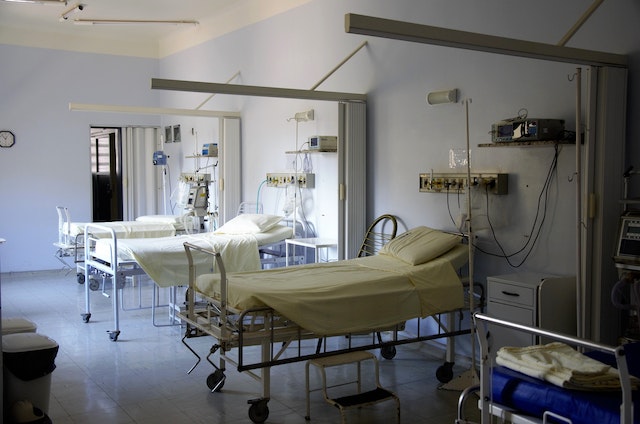The time has come for American hospitals to leave the US News and World Report rankings
The time has come for American hospitals to leave the US News and World Report rankings

The top rankings are proudly presented by US News & World Report for colleges, law and medical schools, and hospital systems each year. Prior to expanding to US hospitals in 1990 and pediatric hospitals in particular in 2007, US News began producing rankings in higher education in 1983.
When they withdrew from the annual law school rankings, Yale Law School prompted a nationwide debate over the suitability of US News rankings. As a result, many prestigious medical schools, including those at Harvard, Stanford, and the University of Washington (UW), resigned from the US News rankings of medical schools. The University of Washington claimed that their decision to stop participating in medical school rankings was motivated by the belief that the focus on status and notoriety without any objective assessment of the quality of education is dissonant with their vision for the future of medicine. The university's objectives of fostering an inclusive learning environment and building a varied and culturally humble workforce are also at odds with the US News rankings system, according to UW.
The top rankings are proudly presented by US News & World Report for colleges, law and medical schools, and hospital systems each year. Prior to expanding to US hospitals in 1990 and pediatric hospitals in particular in 2007, US News began producing rankings in higher education in 1983.
When they withdrew from the annual law school rankings, Yale Law School prompted a nationwide debate over the suitability of US News rankings. As a result, many prestigious medical schools, including those at Harvard, Stanford, and the University of Washington (UW), resigned from the US News rankings of medical schools. The University of Washington claimed that their decision to stop participating in medical school rankings was motivated by the belief that the focus on status and notoriety without any objective assessment of the quality of education is dissonant with their vision for the future of medicine. The university's objectives of fostering an inclusive learning environment and building a varied and culturally humble workforce are also at odds with the US News rankings system, according to UW.
It's time for US hospitals to leave the US News rankings, following the lead of medical and law schools.
Identifying institutions that offer the greatest quality of treatment for children with the most critical or difficult medical issues is how US News & World Report characterizes its goal for its Best Children's Hospital rankings. US News assesses the effectiveness of each hospital specialization based on its performance across three domains: organization, process, and outcomes—in order to determine the Children's Hospital rankings. A hospital's particular resources are related to the structure (for example, nursing ratios, specialized clinics). The hospital's procedures are its acts (for example, best practices, participation in infection prevention efforts). Patients' real experiences are referred to as outcomes (for example, survival, adverse events). Each specialty ranking calculates a final score that establishes the "top ranking" of a speciality by equally weighting the structure, method, and results scores. Children's Hospitals are ranked by US News according to their performance in ten different specialities and as best children's hospitals overall.
With such a lengthy history and a methodology report that is more than 150 pages long, it makes sense that hospital patients would consider the US News rankings as an unbiased observer acting in their best interests.
A closer examination of what US News appreciates inside its speciality rankings may provide insight about who it values, even if the ranking process first seems to be intelligent and thorough. This is particularly critical given the growing awareness of the unequal treatment given to Black, Indigenous, and People of Color (BIPOC) groups in US hospitals.
To demonstrate how not all communities are equally weighted in the US News rankings, consider how two diseases—one that primarily affects White children (cystic fibrosis) and one that primarily affects Black children (sickle cell disease)—are valued in relation to one another in the Children's Hospital methodology.
Both sickle cell disease (SCD) and cystic fibrosis (CF) are genetic conditions that have a terrible effect on the lives and health of individuals affected. 35,000 Americans suffer from CF. About three times as many individuals are affected with SCD, which also accounts for more than 40 times as many hospitalizations.
The people that these disorders affect are a key distinction. 1 in 3,500 White and 1 in 17,000 Black People have CF, respectively. SCD, on the other hand, affects 1 in every 365 Black or African American babies, and it is sufficiently uncommon among White newborns that the Centers for Disease Control and Prevention does not provide a prevalence number.
SCD is cited less in US News' Children's Hospital rankings than CF, despite having a greater effect on US citizens and leading to more hospitalizations. Meanwhile, cystic fibrosis (CF) is one of the severe diseases with a graded expertise, ranked under the pulmonology speciality rankings, where 19 out of the possible 42 points are devoted to achievement in treating cystic fibrosis patients.
It's time for US hospitals to leave the US News rankings, following the lead of medical and law schools.
Identifying institutions that offer the greatest quality of treatment for children with the most critical or difficult medical issues is how US News & World Report characterizes its goal for its Best Children's Hospital rankings. US News assesses the effectiveness of each hospital specialization based on its performance across three domains: organization, process, and outcomes—in order to determine the Children's Hospital rankings. A hospital's particular resources are related to the structure (for example, nursing ratios, specialized clinics). The hospital's procedures are its acts (for example, best practices, participation in infection prevention efforts). Patients' real experiences are referred to as outcomes (for example, survival, adverse events). Each specialty ranking calculates a final score that establishes the "top ranking" of a speciality by equally weighting the structure, method, and results scores. Children's Hospitals are ranked by US News according to their performance in ten different specialities and as best children's hospitals overall.
With such a lengthy history and a methodology report that is more than 150 pages long, it makes sense that hospital patients would consider the US News rankings as an unbiased observer acting in their best interests.
A closer examination of what US News appreciates inside its speciality rankings may provide insight about who it values, even if the ranking process first seems to be intelligent and thorough. This is particularly critical given the growing awareness of the unequal treatment given to Black, Indigenous, and People of Color (BIPOC) groups in US hospitals.
To demonstrate how not all communities are equally weighted in the US News rankings, consider how two diseases—one that primarily affects White children (cystic fibrosis) and one that primarily affects Black children (sickle cell disease)—are valued in relation to one another in the Children's Hospital methodology.
Both sickle cell disease (SCD) and cystic fibrosis (CF) are genetic conditions that have a terrible effect on the lives and health of individuals affected. 35,000 Americans suffer from CF. About three times as many individuals are affected with SCD, which also accounts for more than 40 times as many hospitalizations.
The people that these disorders affect are a key distinction. 1 in 3,500 White and 1 in 17,000 Black People have CF, respectively. SCD, on the other hand, affects 1 in every 365 Black or African American babies, and it is sufficiently uncommon among White newborns that the Centers for Disease Control and Prevention does not provide a prevalence number.
SCD is cited less in US News' Children's Hospital rankings than CF, despite having a greater effect on US citizens and leading to more hospitalizations. Meanwhile, cystic fibrosis (CF) is one of the severe diseases with a graded expertise, ranked under the pulmonology speciality rankings, where 19 out of the possible 42 points are devoted to achievement in treating cystic fibrosis patients.
There is no hematological part, and there is no SCD subsection, which is inappropriate. A structured outpatient sickle cell program might earn a hospital one point. The most recent editions have included an equity, diversity, and inclusion (EDI) element worth 2% of total points. Many of the characteristics originate from data that medical systems have long collected: information on parents and families such as race, ethnicity, and gender. There are additional points available for leaders who have completed EDI training. Those are clearly a step ahead, but consider them to be one stride forward and two steps back, given the conspicuous near-absence of SCD in the ranking process. This method of assessing EDI is intrinsically flawed since it neither addresses the quality of treatment offered to BIPOC patients nor evaluates the effects of the EDI training. Educating leaders on the significance of diversity, equality, and inclusion is an important first step toward education and institutional culture change, but assessing how that training affects patient care is an important next step.
There is no hematological part, and there is no SCD subsection, which is inappropriate. A structured outpatient sickle cell program might earn a hospital one point. The most recent editions have included an equity, diversity, and inclusion (EDI) element worth 2% of total points. Many of the characteristics originate from data that medical systems have long collected: information on parents and families such as race, ethnicity, and gender. There are additional points available for leaders who have completed EDI training. Those are clearly a step ahead, but consider them to be one stride forward and two steps back, given the conspicuous near-absence of SCD in the ranking process. This method of assessing EDI is intrinsically flawed since it neither addresses the quality of treatment offered to BIPOC patients nor evaluates the effects of the EDI training. Educating leaders on the significance of diversity, equality, and inclusion is an important first step toward education and institutional culture change, but assessing how that training affects patient care is an important next step.

The dramatic overvaluation of CF over SCD in rankings demonstrates how much US News has failed to critically assess institutional racism in medicine, a shortcoming that merely perpetuates rather than solves health disparities.
The consequences of not having an illness like SCD represented in these rankings cascade into other parts of financing. Despite having one-third the number of patients as SCD, CF presently gets around $2,807 in government funding per person, while SCD receives $812 per person. CF is also the subject of many more research publications (1,594 versus 926). If US News included SCD more prominently in its scoring mechanisms, hospitals might be more willing to invest their limited resources in developing staff dedicated to excellence in SCD care or cultivating researchers who can compete for government research grants to advance novel therapies that will improve care for years to come.
Pediatricians witness how underinvestment in SCD vs CF leads to real-world variations in patient outcomes in my everyday encounters with patients and families. CF patients celebrate no hospital admissions in years due to fantastic new drug developments, and SCD patients sadly state that they didn't want to go into the hospital for fear of their experiences not being fully understood or addressed by staff who are inexperienced in their condition. The SCD community's lack of attention and relevance is obvious, and it has a direct impact on access to adequate health care.
If hospitals, like colleges, detach themselves from ratings, we may emphasis on the purpose of serving our patients and communities fairly, without being overly swayed by erroneous US News incentives.
The dramatic overvaluation of CF over SCD in rankings demonstrates how much US News has failed to critically assess institutional racism in medicine, a shortcoming that merely perpetuates rather than solves health disparities.
The consequences of not having an illness like SCD represented in these rankings cascade into other parts of financing. Despite having one-third the number of patients as SCD, CF presently gets around $2,807 in government funding per person, while SCD receives $812 per person. CF is also the subject of many more research publications (1,594 versus 926). If US News included SCD more prominently in its scoring mechanisms, hospitals might be more willing to invest their limited resources in developing staff dedicated to excellence in SCD care or cultivating researchers who can compete for government research grants to advance novel therapies that will improve care for years to come.
Pediatricians witness how underinvestment in SCD vs CF leads to real-world variations in patient outcomes in my everyday encounters with patients and families. CF patients celebrate no hospital admissions in years due to fantastic new drug developments, and SCD patients sadly state that they didn't want to go into the hospital for fear of their experiences not being fully understood or addressed by staff who are inexperienced in their condition. The SCD community's lack of attention and relevance is obvious, and it has a direct impact on access to adequate health care.
If hospitals, like colleges, detach themselves from ratings, we may emphasis on the purpose of serving our patients and communities fairly, without being overly swayed by erroneous US News incentives.




























